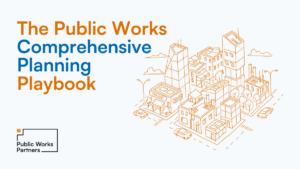In New York City, most major urban planning projects such as rezonings and developments on City-owned land will undergo a Uniform Land Use Review Procedure (ULURP) and a pre-ULURP environmental review (EIS). Projects that do not undergo ULURP include those that follow existing zoning laws (“as-of-right” development) or require very minor changes, as well as those under state jurisdiction. At Public Works Partners, we help federal, state, and city agencies—the sponsors and applicants of proposed projects—navigate the ULURP and EIS processes, which can be confusing even to those who go through it regularly. Though it is complex, ULURP is an essential tool for creating a more equitable planning environment because it ensures a predictable and consistent review process that seeks feedback from the public and approval from elected leaders.
For decades, New York suffered without this uniform process and New Yorkers experienced even greater inequity in the city planning process than they do today. While ULURP was much needed when the City introduced it in 1975, the process is far from perfect and draws criticism for not being inclusive enough, for making unjustified assumptions about New York City communities, and for taking too long.
Before ULURP can begin, the applicant proposing the action must spend time gathering information and conducting an environmental review to assess and determine the proposed action’s environmental, economic, and social impacts. This pre-ULURP phase can take several months to several years to complete.

After environmental review, ULURP begins. ULURP consists of two phases: the advisory phase and the voting phase. During the advisory phase, the Community Board and Borough President review the proposal and make recommendations. As part of its review, which lasts 60 days, the Community Board holds a public hearing. With this input, the Board makes its recommendation on the proposal to the New York City Department of City Planning (DCP). The Borough President then reviews the proposal and makes a recommendation in 30 days or waives its right to do so. The Borough Board gets involved if the proposal spans more than one community district. In this case, the Borough Board also holds a public hearing. Like the Borough President, the Board makes a recommendation to DCP or waives its right to do so. The advisory phase allows community leaders an opportunity to review and consider the proposal, and then make informed recommendations that will act as a guide for City agencies in the voting phase.
The proposal then moves to the voting phase during which the City Planning Commission, City Council, and Mayor vote on the proposed action. Over a 60-day period, the City Planning Commission reviews the proposal and holds both a public hearing and public review session during which DCP appears before the Commission to explain details and answer questions. The Commission either issues an approval, an approval with modifications, or a disapproval to City Council. City Council then reviews the proposal, gathers public feedback at a public hearing, and votes in a 50-day period. Any proposed modifications by City Council go back to the City Planning Commission to review for no more than 15 days. Finally, the Mayor has 5 days to veto City Council’s decision. City Council may only override the Mayor’s veto with a 2/3 majority vote.
At Public Works Partners, we support clients as they navigate ULURP and engage the public at key points in the review. We leverage our project management and stakeholder engagement expertise to create effective solutions that meet the needs of agencies, developers, and community groups at every step of the review process.
[author] [author_image timthumb=’on’]https://publicworkspartners.com/wp-content/uploads/2020/01/Summer-2-scaled.jpg[/author_image] [author_info]Summer is an analyst at Public Works Partners. She supports the Client Services team in managing multi-stakeholder projects. Her combined experiences in public and nonprofit sectors allow her to approach project challenges and identify opportunities from varying angles, a trait that is important for our clients’ dynamic projects.[/author_info] [/author]





 Public Works Partners is a WBE/DBE-certified urban planning and consulting firm. Our expertise lies in creating innovative, equitable, and sustainable solutions to complex problems.
Public Works Partners is a WBE/DBE-certified urban planning and consulting firm. Our expertise lies in creating innovative, equitable, and sustainable solutions to complex problems.